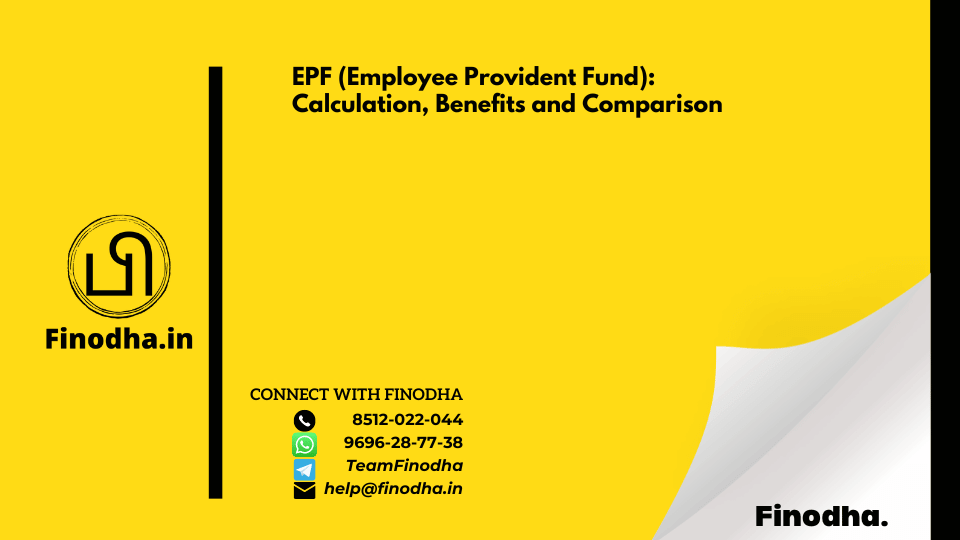Important Keyword: EPF, EPF Calculation, Tax Saving Investments.
Table of Contents
EPF (Employee Provident Fund): Calculation, Benefits and Comparison
The Employee Provident Fund (EPF) is essentially a savings scheme designed for employees. Every month, a part of your salary is deducted towards your EPF account. This fund serves as a financial resource that can be utilized during periods of unemployment or after retirement. Introduced by the Government of India, EPF aims to encourage savings among salaried individuals.
EPF is overseen and managed by the Employees Provident Fund Organisation (EPFO), which operates under the direct jurisdiction of the Government. This ensures that the fund is regulated according to established norms and guidelines.
Employee Provident Fund Applicability
EPF (Employee Provident Fund) is a retirement scheme overseen by the EPFO (Employees Provident Fund Organisation). It is mandatory for organizations or factories with 20 or more employees to register with the EPFO. Entities with fewer than 20 employees can opt for voluntary enrollment. All employees earning wages up to INR 15,000 per month must be enrolled in this scheme.
Individual employees cannot register independently with the EPFO; registration must be done by their employers.
Employee Provident Fund Withdrawal Eligibility includes:
- Retirement: Upon reaching 55 years of age, an employee can withdraw the entire EPF amount.
- Pre-Retirement: From the age of 54 years, an employee can withdraw up to 90% of the EPF funds, one year before retirement.
- Job Change: After one month of unemployment, an employee can withdraw 75% of the EPF amount. The remaining balance is transferred to the new job’s PF account.
- Unemployment: After two months of unemployment, an employee can withdraw the entire EPF amount.
How is Employee Provident Fundtaxed?
The taxation of EPF withdrawals varies based on specific circumstances, with exemptions granted under certain conditions. The following table explains EPF taxation in all scenarios:
| Scenario | Taxation |
| Employee contribution to PF | A deduction can be claimed up to INR 1.5 Lakhs under section 80C in a year |
| Employer contribution to PF | If the employer’s aggregate contribution towards PF, NPS, & Superannuation Fund exceeds INR 7.5 Lakhs in a year then such excess will be taxable as perquisite under Salary. Any interest/ dividend on such excess contribution will also be taxable. |
| Interest on EPF | If an employee contributes more than INR 2.5 Lakhs in a year then interest on such excess contribution is taxable as other source otherwise it is exempt. TDS is applicable on such interest. This limit will change to INR 5 Lakhs if the employer is not contributing to PF. |
| EPF is withdrawn after 5 years of continuous service | It is exempt from tax. For calculating 5 years, the tenure with the previous employer will also be considered. |
| EPF is withdrawn before the completion of 5 years | 1. Employer contribution and interest on it is fully taxable as salary. 2. Employee contribution is not taxable, provided it was not claimed under 80C as a deduction, if so then it will be taxable as salary. 3. Interest on employee contribution is taxable as other source. Note: TDS @10% under section 192A will be deducted if the amount withdrawn is more than INR 50,000. |
| Transfer of PF from one employer to another | Not taxable |
| EPF is withdrawn from unrecognized PF | It will be taxable irrespective of the period of service |
Note: If EPF is withdrawn before the completion of 5 years of continuous service due to the employee’s ill health, discontinuance of business, or reasons beyond the employee’s control then such withdrawal will be exempt from tax.
What is the current EPF Rate of Interest?
An interest rate for the Employee Provident Fund (EPF) is determined annually by the government and the central board of trustees. Interest earned on credits in one’s PF account is credited annually on 1st April. Historically, EPF interest rates have ranged from 8% to 12%. For the financial year 2023-24, the interest rate stands at 8.25%. Importantly, interest accrued on EPF contributions during employment is tax-free.
To calculate interest on EPF:
- Employee’s Contribution: Ms. Amrita earns a monthly salary of INR 20,000. Her contribution to EPF is 12% of her Basic Salary + DA, totaling INR 2,400.
- Employer’s Contribution: The employer also contributes 12% of Ms. Amrita’s Basic Salary + DA. This amount is split as follows:
- 3.67% (INR 734) goes into Ms. Amrita’s EPF account.
- 8.33% (INR 1,666) goes into the Employee Pension Scheme (EPS).
Therefore, the total monthly contribution towards Ms. Amrita’s EPF account is INR 3,134 (2,400 + 734).
- Interest Calculation: The annual interest rate of 8.25% translates to a monthly interest rate of 0.688% (8.25%/12).
- Monthly interest accrued = INR 3,134 * 0.688% = INR 21.56.
It’s important to note that although interest accrues monthly, it is credited to the EPF account only at the end of the financial year, typically on 1st April of the following year. This process ensures that employees benefit from compounded interest on their EPF contributions.
What are the Different EPF Forms?
An EPF Form plays a crucial role and is mandatory for various activities related to an employee’s EPF account. These forms are essential for processes such as nomination, availing tax deductions, transferring accounts, and accessing monthly pension benefits.
Below-mentioned is the list of forms serving different purposes:
| Form | Purpose of the Form |
| Form 2 | For Nomination and Declaration |
| Form 5 | For Registration |
| Form 5IF | To avail of a claim under the EDLI Scheme |
| Form 10C | To avail of withdrawal benefits or scheme certification |
| Form 10D | To avail of a monthly pension |
| Form 11 | To transfer the EPF account |
| Form 14 | To purchase an LIC policy |
| Form 15G | To avail of tax-saving benefits on interest |
| Form 19 | For settling EPF |
| Form 20 | For settling EPF in case of death |
| Form 31 | For EPF Withdrawal |
Comparison of Different Tax-Saving Investment Schemes
| Investments | Returns | Lock-In-Period | Risk |
| EPF | 8.25%* | No lock-in period | Low Risk |
| ELSS | 10-12%* | 3 Years | Market Risk |
| FD | 6-7%* | 5 Years | Low Risk |
| NSC | 7-8% | 5 Years | Low Risk |
| NPS | 9-12%* | Till Retirement | Market Risk |
| PPF | 7-8% | 15 Years | Low Risk |
All the above tax savings investment options are tax-deductible up to INR 1,50,000. (*Subject to change)
Read More: Difference between EPF and PPF
Web Stories: Difference between EPF and PPF
Official Income Tax Return filing website: https://incometaxindia.gov.in/





0 Comments